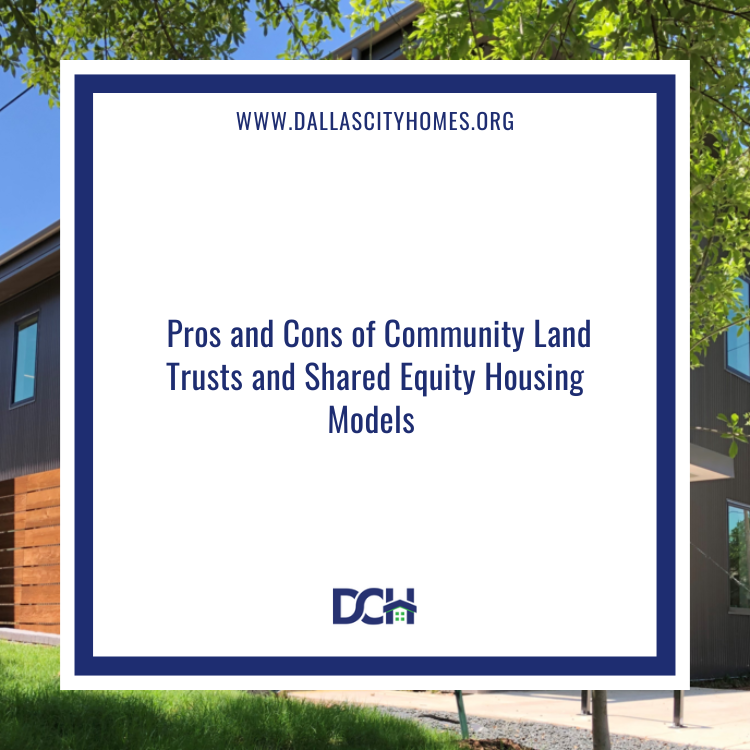Pros and Cons of Community Land Trusts and Shared Equity Housing Models
Affordable housing, especially in urban centers, is an issue we face worldwide. Solutions are needed to create sustainable pathways to homeownership that provide housing and bridge futures. This month, we are looking at different policy and land use approaches that offer new ways for individuals who earn lower incomes to still earn equity by paying into properties with special designations. It is important to note that where possible, traditional homeownership is most desirable because of the equity built, but in the current climate where we are in such a shortage, new solutions are important to discuss. What might not be right for Dallas, might be right for another city, so having these conversations helps all in the fight for fair and equitable housing.
What is Shared Equity Homeownership?
Shared Equity Homeownership is a housing model where homeowners and a nonprofit, community land trust (CLT), or government entity share the cost and benefits of homeownership. In exchange for an affordable purchase price, homeowners agree to resale restrictions, ensuring the community remains affordable and is accessible to the next buyer. The model creates permanent affordability and builds equity more slowly, over time. These models can come in many forms, but one of the most popular in housing policy discussion is the Community Land Trust.
Community Land Trusts (CLTs) are affordable housing models that keep homes permanently accessible to low- and moderate-income families. They effectively separate home ownership from land ownership that keep costs stabilized and reduce displacement from gentrification. Theoretically, they are an urban planning solution that makes a ton of sense, but their implementation can be at the expense of individuals who might otherwise be earning equity from owning a home. DCH explores the pros and cons of CLTs.
Pros of Community Land Trusts: Sharing Land, Sharing Dreams
One of the biggest advantages of CLTs is their ability to preserve affordability. Since the trust owns the land, resale restrictions ensure that homes remain accessible to future buyers at affordable prices. In areas experiencing gentrification, CLTs help protect low- and moderate-income residents from being priced out of their neighborhoods by stabilizing housing costs. CLTs are typically governed by a board that includes residents, community members, and public representatives. This structure ensures that the trust is responsive to the community's needs and promotes long-term neighborhood stability.
CLT homeowners do not benefit from full market appreciation, but they can still build some equity over time, making homeownership better financially than renting. Additionally, many CLT’s offer services meant to promote future homeownership, including financial counseling, home maintenance guidance, and foreclosure prevention assistance.
Cons of Community Land Trusts
Community Land Trust homeowners build some equity, however, the resale restrictions prevent them from receiving full market value appreciation. This limits wealth-building compared to traditional homeownership. It is also not simple to sell out of a CLT. Homeowners must follow the CLT’s resale formula, which ensures affordability but may deter buyers looking for unrestricted property value growth.
Maintaining and starting a community land trust is a big investment in land, legal structuring, and ongoing costs. It can be challenging for policymakers to secure funding to create and run community land trusts. Since CLTs require land acquisition and organizational support, they are not widely available in all communities, limiting access for potential homeowners. The running and managing of a CLT requires a dedicated board, staff, and funding. Governance and administration are more complex than traditional homeownership models. How prevalent are CLT’s already?
Current Climate and Affordable Housing Tax Credit Timeouts
According to the Lincoln Institute of Land, there are currently 308 CLTs in 48 states, D.C., and Puerto Rico as of January 2024—as opposed to 289 in 2021, 225 in 2018, and 162 in 2006. One example that is lauded as a success is in Portland, Oregon, called Proud Ground. It is a tripartisan led community with a nonprofit as one arm, a group of professionals including those in finance and lawyers, who guide lessees, and lessees. The leases are 99 years and are inheritable. This is a successful model and example of a community land trust operating to improve lives and build generational wealth.
This is not without complications in the coming years. Federal programs that incentivized building low income and middle income housing, with a Low Income Housing Tax Credit are not ending. The National Low Income Housing Coalition estimates that nearly 500,000 LIHTC-financed units, representing almost a quarter of all such units in place, will reach the end of their 30-year limit by the end of the decade. Considering the current market, those who live in these residences may be displaced. To shift to community land trusts and shared equity models is a complicated solution considering the challenges in administration and synchronous partnerships.
Community Land Trusts and other shared equity models offer a potential solution to housing affordability and, on their face, are a balance between long-term affordability and homeownership opportunity. However, they also come with trade-offs. Owners will experience limited equity gains and contend with administrative complexity. Additionally, there is limited availability. As housing challenges continue to grow, CLTs are one solution to maintaining affordability but have some drawbacks for administrators, policymakers, and potential shareholders.
Please share your thoughts with DCH below!

